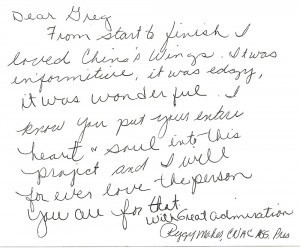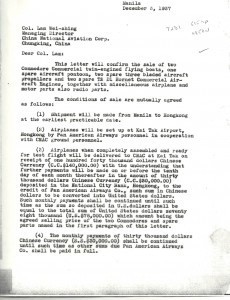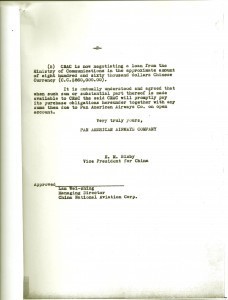Gregory Crouch's Blog, page 35
April 20, 2012
One of the things that makes it all worthwhile…
This note just came in the mail today from CNAC Association President Peggy Maher.
Needless to say, I’m feeling pretty fine right now…
Here’s a great picture of her with her father, Bill Maher, who was so supportive of my China’s Wings project through the entire process, but who passed away just a few months before he could have held one of the first copies.
April 18, 2012
The end of an Era: China’s Wings goes to the garage…
I’m re-organizing the office this week, moving out all the files related to the creation of China’s Wings in the hopes of making room for an (as-yet) unknown story to move in.
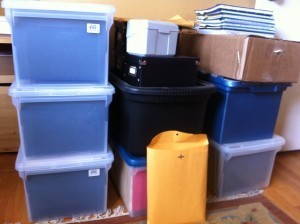
CNAC-related documents, photocopies, 4x6 cards, interview transcripts, and handwritten rough drafts...
This process makes me feel pretty sad — I’m going to miss this story. I’m going to miss all these marvelous people and their incredible adventures living in my head. I’m going to miss thinking about them, pondering their actions and decisions and difficulties and loves, and trying to envision the world in which they lived and bring it to literary life. And I’m also really, really intimidated by the thought of having to do it all over again if I’m going to write another book — which, granted, I very much want to do. It’s such a lot of work.
The volume of material and the colossal volume of work these boxes of documents and writings represent is pretty daunting. Especially knowing that I’ve got to summon the bile to do it all 0ver again.
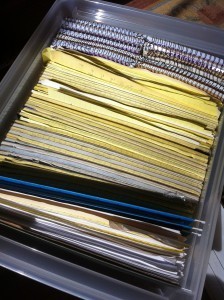
Notebooks, and some of my handwritten rough drafts. I paged through one of those yellow legal pads yesterday -- 49 pages, NOT ONE WORD of which made it into China's Wings.
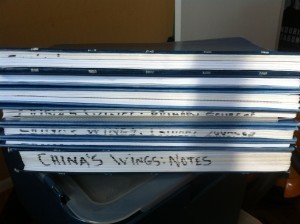
Transcribed interviews: Rosbert, Goutiere, McBride, Rossi, Frieda and TT Chen, Al and Ced Mah, Bill Maher, Langhorne Bond, and Moon Chin
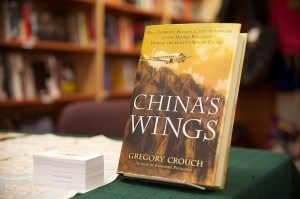
All that stuff above cooked down into this...
So, does anybody know a good story? I’m interested in finding a good one…
April 17, 2012
The official winery of China’s Wings

Cartograph Wines
I hereby anoint Cartograph Wines as the official winery of China’s Wings. Founded by Alan Baker and my dear friend Serena Lourie, Cartograph is a micro winery devoted to crafting “balanced, nuanced, and complex” pinot noirs and a “dry, crisp, balanced” Gewürztraminer. As a white wine guy, I particularly enjoy their Gewürzts, which focus on the dry and delicious taste of the grape rather than going in the direction of saccharine and banal, like most of the type.
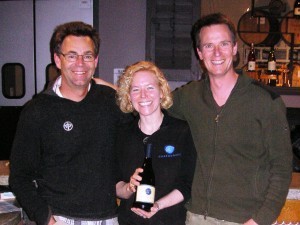
With Serena & Alan at the Garagiste event
Serena’s an extraordinarily socially gifted human being, and before she moved to Healdsburg with Alan to found Cartograph, I was happily tangled in the web of her enormous San Francisco social circle. I think there’s quite a number of us whose social lives haven’t really recovered from her move to the wine country, but I’m also sure all of us are happy to witness the success she and Alan have enjoyed with Cartograph and with the Garagiste Healdsburg tasting room they opened last summer. Garagiste is an fine place to while away a Healdsburg afternoon, one of their excellent wines in hand.
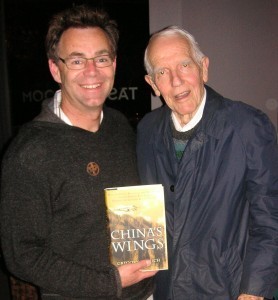
With CNAC Navigator Joe Brower at Garagiste. (Joe's brother is Sierra Club legend David Brower)
Last Friday night, Serena and Alan hosted a China’s Wings event at Garagiste, and it was a resounding success. (And a great delight to present my CNAC & William Bond slide show and talk with a glass of their Gewürztraminer in hand.) We were honored to have CNAC navigator Joe Brower (1947-1949) on hand for the event, along with his wife Gayle, and I got Joe to sign my personal copy of China’s Wings. Also at the show were two scions of CNAC pilots: Valerie Kendrick Parish (in the photo below) and Steve Michiels, son of CNAC pilot Joe Michiels — who took all the pictures.
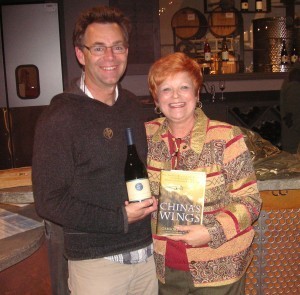
With Valerie Kendrick Parish, daughter of CNAC captain Leonard Lee Parish
April 16, 2012
Another adventure in the Consolidated Commodore
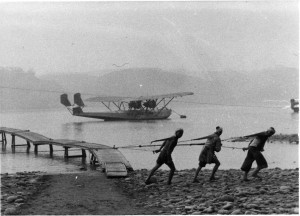 On February 4, 1938, Hugh Woods was bringing one of CNAC’s twin-engine Commodore flying boats down from Chungking to Hankow. One-hundred miles west of the temporary capital, one of his oil coolers sprung a serious leak. Woody executed a perfect forced landing on the Han River, but the under-lubricated engine overheated and seized. None of his passengers got so much as a scratch, and CNAC’s sole surviving Loening Air Yacht retrieved them in relays to Hankow.
On February 4, 1938, Hugh Woods was bringing one of CNAC’s twin-engine Commodore flying boats down from Chungking to Hankow. One-hundred miles west of the temporary capital, one of his oil coolers sprung a serious leak. Woody executed a perfect forced landing on the Han River, but the under-lubricated engine overheated and seized. None of his passengers got so much as a scratch, and CNAC’s sole surviving Loening Air Yacht retrieved them in relays to Hankow.
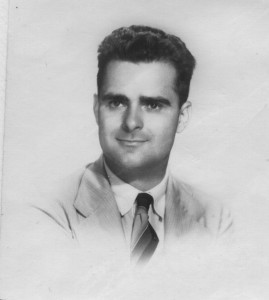
Hugh Woods
Recovering the stranded Commodore was a much larger problem, since the company’s two spare Commodore engines (635-hp Pratt & Whitney T2D1 Hornet Commercial Aircraft Engines), were tangled inside the shipping administration of the Hong Kong-Canton-Hankow railroad — which, since the outbreak of the Battle of Shanghai the previous summer, had been Nationalist China’s most important connection to the outside world. The motors might arrive in a week, but it could well take another month before they appeared. (CNAC apparently hadn’t paid enough squeeze to ensure priority treatment.) There was a wrecked Junkers in Ichang that had engines of the same type – it had been forced down and destroyed by the Japanese – but it belonged to the Generalissimo, and no one would give CNAC Operations Manager Bond permission to cannibalize its idle engines.
For two weeks, the flying boat lay anchored on the Han River where Woody had landed it, but it was right under the flight route of Japanese bombers on their way to and from Ichang, a target they’d pummeled frequently in recent weeks, and the Han River was low. William Bond worried that a junk or sampan in the narrow channel would collide with the Commodore and do further damage. He also had to garrison the plane to prevent it being pillaged by bandits. He badly wanted it returned to Hankow.
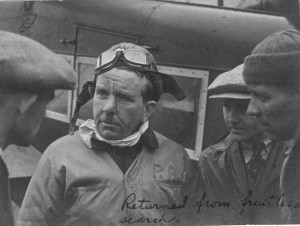
Ernie Allison
Finally, one of his mechanics suggested using a spare 575-hp Loening engine that could be accommodated by the same engine mount. The idea seemed reasonable, but Bond didn’t have a spare pilot. However, his old friend Ernie Allison was in Hankow, and Allie was always up for an interesting flight. Bond asked Allie to captain the rescue flight, Allie agreed, and Bond had Allison, himself, two mechanics, and a spare 575-hp engine dropped off at the Commodore’s Han River anchorage by the Loening. Two mechanics unhung and stowed the frozen motor and installed the 575-hp Hornet.
Bond served as Allie’s co-pilot, and the asymmetric arrangement gave the feeling of working a horse and a mule in double harness, which offended Bond’s aesthetic sense, but once Allie got the propellers properly synchronized the Commodore soared off the Han River and flew without trouble. Bond returned it to regular service the next day, February 26, and he rode back to Chungking on the unbalanced Commodore as a passenger – along with twelve other paying customers and a healthy load of airmail.
Weeks passed before they were able to restore the proper engine balance, but CNAC used the plane regardless.
CNAC’s gasoline shortage and Woody’s forced landing: Allie to Florence, February 2, 1938, text provided to the author via email by Nancy Allison Wright, November 2005; Bond to Bixby February 4, 1938, the Bond Papers; Details of the engine failure and the location of the force-down: Bond to Bixby, February 27, 1938, the Bond Papers.
635-hp Pratt & Whitney T2D1 Hornet Commercial aircraft engine: Bixby to Colonel Lam Wei-shing, December 3, 1937, the Bond Papers.
CNAC had two spares of that type tangled in shipping complications with the railway’s freight administration: Bond to Bixby, February 4, 1938, the Bond Papers.
The Hankow-Canton-Hong Kong railroad, Nationalist China’s most important connection to the outside world since the Japanese seizure of the Lower Yangtze: Bosshard, Walter, “Prosperous Hong Kong,” The China Weekly Review, August 27, 1938.
Returning the Commodore to service: Bond to Bixby, February 27, 1938, the Bond Papers.
April 12, 2012
The Last Consolidated Commodore
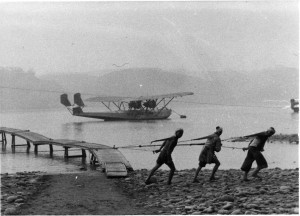
CNAC Consolidated Commodore on the Yangtze at Chungking
Building on the CNAC and the Consolidated Commodore post I made yesterday, a few weeks ago, Jerry Butsko, a volunteer archivist at the San Diego Air and Space Museum who’d read China’s Wings, called me and brought to my attention the likelihood that Moon Chin is the last Consolidated Commodore pilot left in the world.
Only fourteen of the Commodores were built, and none of them survived their years of service. But in 1963, a Commodore that had caught fire and sunk in a remote Canadian lake was discovered in only 100 feet of water, instead of the 600 feet that had previously been thought. Two salvage attempts have failed to raise the plane, but a modern effort fronted by the San Diego Air & Space Museum is underway in order to bring the plane to the museum, which makes good sense since Consolidated Aircraft did much of its manufacturing in San Diego. Here’s the The Last Commodore Recovery Project website.
Best of all is the short film they’ve posted about the Commodore project, which includes black and white footage of Commodores in action spliced in at several points.
The San Diego Air & Space Museum has a fine Consolidated/Convair Online Exhibit posted, with lots of interesting photographs.
interviewed by NPR’s Robin Young for “Here and Now”
A few weeks ago, Abbas Sabetian of the Alpine Club of Iran (ACI) and I were interviewed by NPR’s Robin Young for “Here and Now.” Our story, US and Iranian Climbers Practice Mountain Diplomacy, about the climbing exchange between the American Alpine Club and the ACI, aired Tuesday, April 10, and includes a few of my photos.
“The Peaks of Persia” story I wrote for the April issue of The Atlantic sparked the conversation.
Best news of all about the exchanges, is that it seems they’re going to continue. A women’s exchange is in the works for this coming summer, in Colorado.
April 11, 2012
CNAC and the Consolidated Commodore
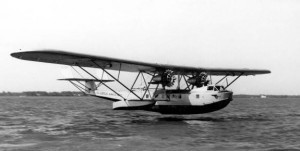
Consolidated Commodore
The Consolidated Commodore is the plane Moon Chin flew during the Hankow evacuation in October, 1938 (China's Wings, Chapter 14), and he's quite possibly the last Commodore pilot alive.
An all-metal monoplane flying boat originally designed to meet US Navy patrol plane specifications, the Consolidated Commodore cruised at 108 miles per hour, and it entered service for New York-Rio-Buenos Aires (NYRBA) line in 1929 and 1930. Only fourteen Commodores were built, and they were used in regular service during the early 1930s, predominantly in the Caribbean and up and down the coasts of South America, but their haydey was over by 1935. The major airlines removed them from front-line service and replaced them with a higher performing seaplanes. Pan Am crated up two of their lumbering, fuel-inefficient, twin-engine Commodores and shipped them to the Philippines, hoping to use them to establish an inter-island subsidiary that would feed traffic to their transpacific line. Unfortunately, Harold Bixby couldn't secure the necessary permissions from the Philippine government, and the two flying boats languished in their shipping crates.
They were still in their crates in Manilla in late 1937, after China's catastrophic defeat in the Battle of Shanghai, as the Japanese were driving toward the Nationalist capital at Nanking (China's Wings, chapters 8, 9, and 10). Colonel Lam Whi-shing was CNAC's managing director at the time, and although Bond never wavered in his desire to remove Colonel Lam and all Chinese Air Force influence from CNAC, circumstances forced Bond to work much closer with Colonel Lam through late November and early December, 1937. Bond's respect for Colonel Lam grew as a result.[i]
CNAC desperately needed airplanes in late 1937, and Bond tipped Colonel Lam to the existence of the two Pan Am Commodores languishing in Manila.[ii] CNAC could use the old flying boats on the Yangtze above the Japanese occupation. Bond and Colonel Lam flew to the Philippines in early December to examine them.[iii] Colonel Lam decided to buy the airplanes. He also realized that Bixby would have a hard time finding another buyer – few places in the world besides China could profitably employ such obsolete aircraft. Bond begged conflict of interest and stepped back to watch the two men haggle, Pan Am v. CNAC.
In the end, Colonel Lam bought both airplanes, one spare pontoon, a pair of propellers, two extra T2D1 Hornet Commercial Aircraft Engines, and other miscellaneous airplane, engine, and radio parts for U.S. $78,000 (just over one million modern dollars),delivered to Hong Kong and assembled by Pan Am, an especially fine purchase considering the $4,000 cost of shipping the planes and spares to Hong Kong.[iv]
Here are the two pages of the purchase agreement:
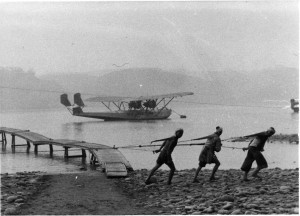
CNAC Commodore anchored off Chungking's Sanhupa Airport in 1938
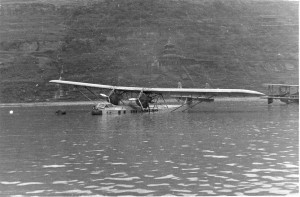
The sunken Commodore. Note the undamaged Loening floating off the Commodore's left wingtip
Beginning in early 1938, CNAC used the Commodores to good effect plying the Yangtze above Hankow.
The sunken one below was damaged by an unexpected storm that struck Chungking overnight in the third week of April, 1938. Sledgehammer winds tore rooftops and felled walls in the hilltop city. Down at river level, night was blackness and chaos and torrents of wind-driven rain. The storm wrecked twenty-five junks and drowned their crews. Eighty and ninety mile-per-hour winds gusts flogged the nine planes on Sanhupa Airport or anchored in the river beside it — five of which belonged to CNAC: a DC-2, a Stinson, a Commodore, a Dolphin, and a Loening. The furious storm overwhelmed efforts to secure them. A little Beechcraft owned by the Chinese Army blew two thousand feet across the airport like a tumbleweed, and it would have gone into the river except for the intervention of a hut in the shack village at the northeast corner of the island. The Beechcraft smashed the hut, but it tangled in the wreckage and blew no further. CNAC's DC-2 was parked next to the passenger shed. A gust slammed the Douglas into the structure and collapsed the shed onto the airplane's tail. The Stinson flipped onto its back. The Commodore and the Dolphin were anchored next to each other in the river. The windstorm smashed them together, dragged their anchors, and blew them aground. Rocks on the river-bottom punched holes in their hulls, which was probably fortunate since both airplanes flooded and settled to the tops of their hulls without being swept away. Their high wings kept their engines above water level.
The worst of the storm broke overnight. News of the disaster prompted William Bond to fly up from Hong Kong. The airport he reached in the afternoon was a wind-blown shambles. Miscellaneous debris fluttered in dying breezes. Wind had collapsed all four of CNAC's shacks and scattered their contents. Bond threw himself into the recovery, and he found it a comfort to be confronted with concrete problems and obvious solutions. A steady rain nagged the salvage efforts, made even more difficult because Chinese Army pressgangs had recently stripped Chungking of coolie laborers, and those few who had escaped involuntary enlistment were busy building air raid shelters. Bond and the ground staff had a devil of a time with the sunken flying boats. They couldn't just drag them ashore, because the rocky riverbed would shred the hulls. Swift, chest-deep current raced past the two flying boats, but eventually the mechanics were able to raise the wrecks enough to slide beaching gear beneath the sunken planes and haul the protected hulks ashore with thick hawsers and brute manpower.
Bond assessed the storm's damage when the flying boats on solid ground. The collision of the two flying boats had torn a hole in the leading edge of the Dolphin's left wing and bent its right pontoon. The Commodore was in much worse shape. Aside from several holes in its hull, the trailing edge of its elevator was mangled and torn, its left pontoon was holed and flooded, and both of the struts that braced the pontoon against the hull were bent and ruined. The collapse of the passenger shed onto the DC-2's tail had torn the right elevator and snapped its hinge bracket. The right aileron was torn and the wingtip badly dented. CNAC had a spare wingtip and elevator stored in a cave above the Chungking airport, and Bond ordered an aileron flown north from Hong Kong and a hinge bracket "borrowed" from the wreck of No. 24 in Ichang. The engines and controls of all the damaged and flooded airplanes would have to be drained, dried, and thoroughly tested. Bond guessed it would take a week to repair the DC-2 and the Dolphin, three weeks to get the Commodore back into service, and a month to fix the Stinson, his lowest priority.
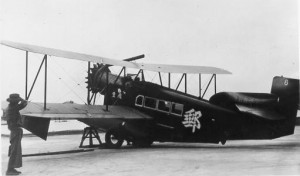 The only undamaged airplane was CNAC's Neanderthal Loening. Like a piece of ancient shoe leather, it had weathered the tempest without a scratch. [v]
The only undamaged airplane was CNAC's Neanderthal Loening. Like a piece of ancient shoe leather, it had weathered the tempest without a scratch. [v]
Next, I'll post about efforts to recover the world's only known Commodore wreckage from the bottom of a lake in Canada.
[i]Bond's growing respect for Colonel Lam: Bond, William L., Wings for an Embattled China, pp. 161 says so specifically; the tone also changed in Bond's contemporaneous correspondence.
[ii] The two Consolidated Commodores: Bond, William L., Wings for an Embattled China, pp. 161; Bixby to Colonel Lam Wei-shing, December 3, 1937, WLB.
[iii] Bond and Colonel Lam went to the Philippines to examine them: Bond to Kitsi, November 22, 1937, WLB; Bond was in the Philippines on December 9 and 10: Florence Allison to her mother, written from Manila, December 9, 1937; Florence Allison to Ernie Allison, December 12, 1937; both in NAW.
[iv] Bond claims that Colonel Lam bought both airplanes for $29,000 total in Wings for an Embattled China, pp. 161, but the actual purchase agreement between Lam and Bixby, dated December 3, 1937, is in WLB, and cites the figure given ($78,000 U.S. for the total purchase, planes and spares); CNAC Chief Mechanic Oscar C. Wilke escorted the Commodores' shipping crates from Manila to Hong Kong on December 14: Florence Allison to Ernie Allison, December 12, 1937, NAW.
[v] The storm in Chungking: Bond to Bixby, written in Chungking, April 24, 1938, WLB; photos of the damage provided to the author by Shirley Wilke Mosley, daughter of CNAC chief mechanic O.C. Wilke.
April 6, 2012
Jim Bridwell weighs in on “The Big Chop”
Climbing legend Jim Bridwell weighs in on “The Big Chop” on Cerro Torre earlier this year.
Here are a few quotes:
“This aggressive policing of individual liberty of others to conform to their ideal of morality are nothing less than fascism”
“In brief I would say; it is not a right to change or destroy someone else’s creation, it only takes away the right of all others to repeat Maestri’s route”
Jim Bridwell weighs in on "The Big Chop"
Climbing legend Jim Bridwell weighs in on "The Big Chop" on Cerro Torre earlier this year.
Here are a few quotes:
"This aggressive policing of individual liberty of others to conform to their ideal of morality are nothing less than fascism"
"In brief I would say; it is not a right to change or destroy someone else's creation, it only takes away the right of all others to repeat Maestri's route"
April 5, 2012
China's Wings and book clubs
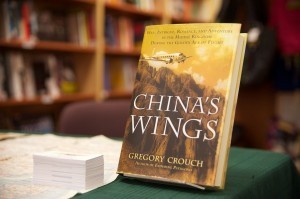 On Tuesday night, I attended a meeting of the UCLA alumni book club that had chosen China's Wings as their March book. We ate pizza, drank, wine, and had lively, enlightening conversations about William Bond, Moon Chin, and CNAC. I showed some of Bond's letters and explained the process I used to organize my research. Very interesting for all of us, I think. For me, it was a genuine pleasure to engage with people who'd absorbed and enjoyed the story so thoroughly and who were curious to learn about the research and writing of the book and to discuss various aspects of it in greater detail.
On Tuesday night, I attended a meeting of the UCLA alumni book club that had chosen China's Wings as their March book. We ate pizza, drank, wine, and had lively, enlightening conversations about William Bond, Moon Chin, and CNAC. I showed some of Bond's letters and explained the process I used to organize my research. Very interesting for all of us, I think. For me, it was a genuine pleasure to engage with people who'd absorbed and enjoyed the story so thoroughly and who were curious to learn about the research and writing of the book and to discuss various aspects of it in greater detail.
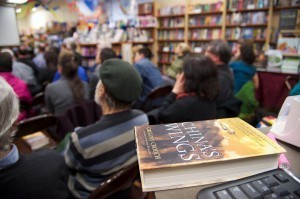 I'd be delighted to coordinate similar events with other book clubs, and although I can't attend events that are far from the Bay Area, we could do a Skype call that would allow us to discuss China's Wings in person. (I'd be able to attend events near Walnut Creek.)
I'd be delighted to coordinate similar events with other book clubs, and although I can't attend events that are far from the Bay Area, we could do a Skype call that would allow us to discuss China's Wings in person. (I'd be able to attend events near Walnut Creek.)
If you'd like to set up something similar with your book club, please don't hesitate to ask.
I'm sure we can get something coordinated.


